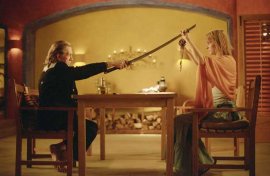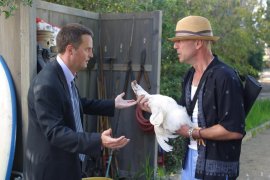 KILL BILL: VOLUME 2
KILL BILL: VOLUME 2
Quentin Tarantino's Kill Bill: Volume 2 is everything I hoped last autumn's predecessor would be (and, for me, wasn't): thrilling, surprising, deeply emotional, and very, very funny.
I recognize that I'm among the minority of reviewers who hated Kill Bill: Volume 1 - in my original review, I wrote that it "reeks of smugness and condescension" - so the fact that I not only admired this follow-up but loved it is astonishing to me; in form and content, there's nothing that radically separates Volume 1 from Volume 2, and yet the tone is so different that, craftsmanship aside, it's hard to believe both parts are by the same filmmaker. As you'd expect, Volume 2 follows The Bride (Uma Thurman) on her quest to annihilate the assassins who left her for dead; after dispatching Vivica A. Fox and Lucy Liu, it's time now for Michael Madsen, Daryl Hannah, and David Carradine's Bill to get what's coming to them. But right from the start - an extended flashback to the initial wedding-chapel massacre, where the dynamics of Bill's and The Bride's relationship begin to surface - it's apparent that Tarantino has more on his mind than a mere homage to the ultra-violent exploitation flicks he copied so strenuously in Volume 1. This time around, his characters have more blood in their veins than they have exploding from their torsos; by humanizing his characters and giving their motivations a proper context, Tarantino allows The Bride's vengeance to have weight and significance, and this makes every event that follows more exciting and, particularly in the scene of Thurman's perfect retribution against Daryl Hannah, gruesomely hilarious.
We expect outrageously inspired set-pieces from Tarantino, and he often outdoes himself in Volume 2, particularly in a sequence where The Bride is buried alive; the scene is a miracle of ingenious sound and lighting effects, harrowing yet - an important distinction - not excruciating. What comes as a shock - and will even to those who loved the first outing - is the depth of feeling exhibited by these previously one-dimensional characters: Madsen and Hannah do their best work in over a decade, and Thurman is positively revelatory; the emoting-in-a-void intensity of her Volume 1 work has morphed into an almost mythic portrayal of anger and grief. (Personally, I wish Carradine was a more interesting performer to listen to, but at least he looks the part, and Tarantino directs him well.) I don't think there's a single scene in Volume 2 that I wanted to end. If, like me, you love Tarantino but loathed Kill Bill's first half, this new work might be the happiest cinematic surprise of the year.
 THE WHOLE TEN YARDS
THE WHOLE TEN YARDS
In the last scene of Howard Deutch's The Whole Ten Yards, the follow-up to 2000's amiably goofy The Whole Nine Yards, Matthew Perry's accident-prone dentist demands that someone explain what, exactly, transpired through the course of the movie, and I totally shared his confusion. It's not just that, by this point, the movie doesn't seem finished; it doesn't seem to have properly started. The Whole Ten Yards is a reckless, offensive sequel, like Cannonball Run II, which assumes that the mere sight of actors re-creating characters we previously enjoyed is enough to fill us with mirth, plotting or logic - or even humor - be damned. Yet the movie is a special kind of terrible sequel. Its filmmakers seem to have seriously overestimated the original's appeal; all throughout the movie you find yourself asking: Who was this movie designed for? (Most everyone I know who saw The Whole Nine Yards liked it, yet I don't know anyone who was clamoring for a continuation.) After 20 minutes of Bruce Willis doing his squinty-eyed hit-man routine and Perry tripping over his own feet - this spaz can't perform the simple act of opening a door without bashing his face in - and characters routinely socking each other in the jaw for a burst of "hilarious" violence, you can't imagine what about the original film made you laugh in the first place. (Amanda Peet, as the gloriously nutty receptionist-turned-hit-woman, was the original's comedic ace-in-the-hole, but she's been so de-fanged here that her character comes off as arbitrary.) Aside from fetishists aroused by the sight of Bruce Willis' bare ass, making what must be its 400th appearance in a major motion picture, the only viewers who will find any entertainment here are Kevin Pollak fans. I am not a Kevin Pollak fan (I don't think I've enjoyed his work since The Usual Suspects nearly a decade ago), but his performance as an aging Mafia don - the father of the Pollak character killed in the original - is truly demented, and at times, even funny; Pollak seems the only one involved in The Whole Ten Yards for anything other than a paycheck.
 BUBBA HO-TEP
BUBBA HO-TEP
It's tricky when filmmakers attempt a horror comedy designed for cult-classic status, because what most often results is a self-conscious, smart-alecky piece that doesn't try too hard to be funny or scary; the moviemakers can shield themselves from attack by making the onscreen events so ridiculous that not believing a moment of the film actually becomes the point. (The titles Attack of the Killer Tomatoes and The Toxic Avenger are more enjoyable than the movies themselves.) So when you hear the setup for Bubba Ho-tep - it concerns Elvis Presley and a man who thinks he's JFK joining forces to battle an Egyptian mummy in their nursing home - your reaction is likely to be twofold: (1) "That movie sounds like fun!" and (2) "That movie can't be as fun as it sounds." And the thrill of Bubba Ho-tep is that writer-director Don Coscarelli and stars Bruce Campbell and Ossie Davis treat the material with such surprising dignity that it transcends its cultish aspirations and entertains us honestly; the film is almost as much fun as it sounds, which, all things considered, is quite a compliment.
You often catch the movie trying too hard, especially in its naked desire to establish more classic dialogue for the Bruce Campbell repertoire. (Campbell is so naturally stylized that he doesn't need the help; this is the man whose "Groovyyy!" line reading is an untouchable in the annals of cult cinema.) Yet, as a director, Coscarelli steals from the best - numerous shots are evocative of Kubrick, Lynch, Raimi, and the Coen brothers - and he establishes an engagingly unsettling atmosphere; Coscarelli always keeps you alert. Ossie Davis, with his great, gravelly tones, is in terrific form, and Campbell is quite tremendous as The King; a friend of mine, admittedly a Campbell fanatic, said his work here bested anything he's ever seen De Niro or Pacino pull off, and after viewing Bubba Ho-tep, playing now (and hopefully forever) at the Brew & View, I found it nearly impossible to argue.










